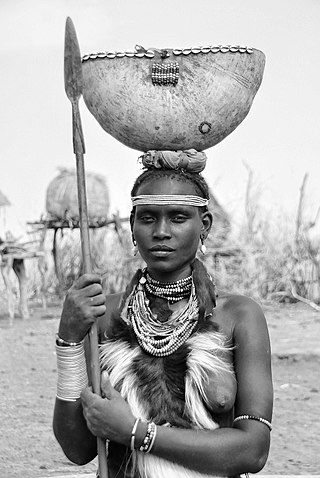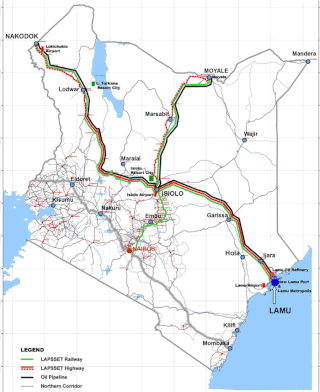Related Research Articles

Lake Turkana formerly known as Lake Rudolf, is a lake in the Kenyan Rift Valley, in northern Kenya, with its far northern end crossing into Ethiopia. It is the world's largest permanent desert lake and the world's largest alkaline lake. By volume it is the world's fourth-largest salt lake after the Caspian Sea, Issyk-Kul, and Lake Van, and among all lakes it ranks 24th.

The Omo River in southern Ethiopia is the largest Ethiopian river outside the Nile Basin. Its course is entirely contained within the boundaries of Ethiopia, and it empties into Lake Turkana on the border with Kenya. The river is the principal stream of an endorheic drainage basin, the Turkana Basin.

The Mursi are a Surmic ethnic group in Ethiopia. They principally reside in the Debub Omo Zone of the Southern Nations, Nationalities, and People's Region, close to the border with South Sudan. According to the 2007 national census, there are 11,500 Mursi, 848 of whom live in urban areas; of the total number, 92.25% live in the Southern Nations, Nationalities, and People's Region (SNNPR).

Environmental issues in Kenya include deforestation, soil erosion, desertification, water shortage and degraded water quality, flooding, poaching, and domestic and industrial pollution.

The Daasanach are a Cushitic ethnic group inhabiting parts of Ethiopia, Kenya, and South Sudan. Their main homeland is in the Debub Omo Zone of the Southern Nations, Nationalities, and People's Region, adjacent to Lake Turkana. According to the 2007 national census, they number 48,067 people, of whom 1,481 are urban dwellers.

The Nyangatom also known as Donyiro and pejoratively as Bumé are Nilotic agro-pastoralists inhabiting the border of southwestern Ethiopia, southeastern South Sudan, and the Ilemi Triangle. They speak the Nyangatom language.
Gilgel Gibe River is a major tributary of the larger Gibe River in southwest Ethiopia in western Oromia Region. It flows in an arc through the south of the Jimma Zone, defining part of the Zone's boundary with that of the Southern Nations, Nationalities, and Peoples' Region as it turns north. It then joins the eastwards flowing Gibe River less than ten miles from its own confluence with the Omo River.
Energy in Ethiopia is energy and electricity production, consumption, transport, exportation, and importation in Ethiopia.
The Gilgel Gibe I Dam is a rock-filled embankment dam on the Gilgel Gibe River in Ethiopia. It is located about 57 km (35 mi) northeast of Jimma in Oromia Region. The primary purpose of the dam is hydroelectric power production. The Gilgel Gibe I hydroelectric powerplant has an installed capacity of 184 MW, enough to power over 123,200 households. The dam is 1,700 m (5,600 ft) long and 40 m (130 ft) tall. Construction on the dam began in 1988 but work was halted in 1994. In 1995 construction restarted with a new construction firm. The power station was commissioned in 2004.

The Gilgel Gibe III Dam is a 250m high roller-compacted concrete dam with an associated hydroelectric power plant on the Omo River in Ethiopia. It is located about 62 km (39 mi) west of Sodo in the Southern Nations, Nationalities, and Peoples' Region. Once fully commissioned, it will be the third largest hydroelectric plant in Africa with a power output of about 1870 Megawatt (MW), thus more than doubling total installed capacity in Ethiopia from its 2007 level of 814 MW. The Gibe III dam is part of the Gibe cascade, a series of dams including the existing Gibe I dam and Gibe II power station as well as the planned Gibe IV and Gibe V dams. The existing dams are owned and operated by the state-owned Ethiopian Electric Power, which is also the client for the Gibe III Dam.
Ethiopia is called the water tower of Africa due to its combination of mountainous areas with a comparatively large share of water resources in Africa. Only a fraction of this potential has been harnessed so far, 1% at the beginning of the 21st century. In order to become the powerhouse of Africa, Ethiopia is actively exploiting its water resources by building dams, reservoirs, irrigation and diversion canals and hydropower stations. The benefits of the dams are not only limited to hydropower. Many dams are multi-purpose dams that are also designed to provide water for irrigation, drinking water and flood control. However, hydropower is expected to be the main benefit of the dams.
The Gilgel Gibe II Power Station is a hydroelectric power station on the Omo River in Ethiopia. It is located about 80 km (50 mi) east of Jimma in Wolaita/Dawro Region. The power station receives water from a tunnel entrance 7°55′27″N37°23′16″E on the Gilgel Gibe River. It has an installed capacity of 420 MW and was inaugurated on January 14, 2010. Almost two weeks after inauguration, a portion of the head race tunnel collapsed causing the station to shut down. Repairs were completed on December 26, 2010.

Dawro is a zone in the South West Region of Ethiopia. The name "Dawuro" represents both the land and the people. It is located at about 500km southwest of Addis Ababa, the capital of Ethiopia and 319 km of Hawassa, the capital of the Sidama Region. Dawuro is bordered on the south by Kucha (woreda) in Gamo Zone, on the west by the Konta Zone, on the north by the Gojeb River which defines its boundary with the Oromia Region,Jimma zone, on the northeast by Hadiya and Tembaro Special Woreda in Central Ethiopia Regional State, and on the east by Wolayita Zone; the Omo River defines its eastern and southern boundaries.

The Grand Ethiopian Renaissance Dam, formerly known as the Millennium Dam and sometimes referred to as the Hidase Dam, is a gravity dam on the Blue Nile River in Ethiopia under construction since 2011. The dam is in the Benishangul-Gumuz Region of Ethiopia, about 14 km (9 mi) east of the border with Sudan.

Lamu Port-South Sudan-Ethiopia-Transport (LAPSSET) Corridor project, also known as Lamu corridor is a transport and infrastructure project in Kenya that, when complete, will be the country's second transport corridor. Kenya's other transport corridor is the Mombasa - Uganda transport corridor that passes through Nairobi and much of the Northern Rift. Some basic LAPSSET infrastructure has been built. The construction of LAPSSET's main components is currently ongoing with construction of the first berth at Lamu Port completed in October, 2019 (situation as per October 2019).. Although the project is not formally stalled, its short to medium term success looks increasingly unlikely. Insecurity and political instability in Kenya are mostly to blame for this, as are more commercially viable alternative pipeline options through Tanzania or Ethiopia. The low oil prices since 2015 also affect LAPSSET's commercial prospects.

The greater Turkana Basin in East Africa determines a large endorheic basin, a drainage basin with no outflow centered around the north-southwards directed Gregory Rift system in Kenya and southern Ethiopia. The deepest point of the basin is the endorheic Lake Turkana, a brackish soda lake with a very high ecological productivity in the Gregory Rift.

Ikal Angelei is a Kenyan politician and environmentalist. She was born in Kitale. She was awarded the Goldman Environmental Prize in 2012, in particular for her voicing of environmental implications of the Gilgel Gibe III Dam, speaking on behalf of Kenyan indigenous communities. She is the founder of the organisation Friends of Lake Turkana which campaigns for environmental justice in the region around the Lake Turkana.
The water conflict between Ethiopia and Kenya is a development dispute due to the receding water resource along the border between Ethiopia and Kenya.

Ethiopia's industrial sectors classified into four basic groups: agriculture, food processing, construction, resources and energy and tourism. Agriculture constitutes over 50% of economic sector in Ethiopia, and the largest dependable economic activity. It includes production of livestock products, beverages, leather and textiles industry. Besides, Ethiopia is the largest exporter of coffee involving over 15 million active workers.
References
- 1 2 3 4 5 6 7 8 9 Thornton, Stuart (16 May 2012). "Case Study. Friends of Lake Turkana work to preserve the lake's ecology by halting construction of an upstream dam". National Geographic. Retrieved 13 May 2019.
- ↑ Gworo, Alice (10 April 2019). "Government Urged To Audit Firms Exploring Oil In Turkana". Kenya News Agency. Retrieved 13 May 2019.
- ↑ Vidal, John (13 January 2015). "Ethiopia dam will turn Lake Turkana into 'endless battlefield', locals warn". The Guardian. Retrieved 13 May 2019.
- ↑ "Kenya's bold and audacious go-getters". The Nation (Kenya). 6 April 2019. Retrieved 13 May 2019.
- ↑ Mwanza, Kevin (3 July 2018). "Ethiopia's dams threaten thousands of Kenyans: environmentalists". Reuters. Retrieved 13 May 2019.
- ↑ Kamau, Macharia. "Fight for water by oil firms may fuel conflict in Turkana". The Standard (Kenya). Retrieved 13 May 2019.
This article needs additional or more specific categories .(October 2023) |